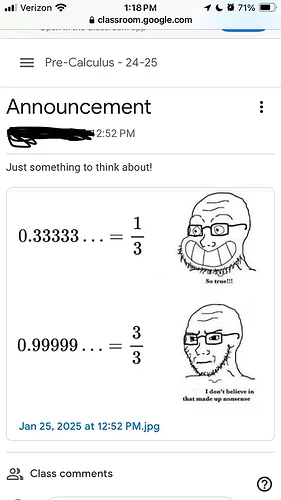yeah
NYAAAAAAAAAAAAAAAAA calculus 
calculus is fine but it’s the boring way to do the problem tbthtbhtbhtbthbtbthbt
removes the JOY and WHIMSY from solving them without it
ok so
i get all of the individual parts. They make lots of sense in my brain. Those are things that compute. They do not fit together
I think this is something I need to just slot into my pondering time because i just dont click sometimes. like my mermeory
If you increase the starting perimeter then the l w h just change proportionally. I think the clearer thing to do would be to set k=1 so you learn all the dimensions as fractions of your total number of blocks
What joyful and whimsical method would you recommend? Number theory?
It’s a calc problem of course I’m gonna do calc
i am at 7x10x10
i. uh. dont actually know what to do with that information now that i think about it
i spend all week being forced to do math and am excited to go to fol on the weekends and talk to people
everyone else on this forum spent the whole week being forced to talk to people and go to fol on the weekends to do math
Oh you have no fucking idea how true this is
The lore is Bad
I think an argument without calculus should be
Suppose the optimal solution was not a cube. Then the length and width (or height, but we can assume it’s not the height without loss of generality) are not equal. Again without loss of generality, we can assume the length is lower than the width.
Increasing the length by x and decreasing the width by x leaves the overall number of blocks of the frame unchanged, but has increased your volume, since (length + x)(width - x) - length * width = x*width - x*length - x^2 = x(width - length - x) > 0 as long as x < (width - length).
It occurs to me now that if you are restricted to integers then maybe the optimal solution can’t be a cube though thbthbthtbhbhtbt
Okay fair enough
this sounds convoluted but as long as you know the fact that the square is the best way to optimize area, then it is fairly intuitive
0.9999… absolutely is exactly equal to 1. Its fraction is 3/3.
I also essentially did that but I always forget you can just make that argument
it really does equal 1 but every argument you learn for why before college sucks
Like when she asked the question I was like “yeah it’s just a cube” using this intuition but I’m so used to doing this exact problem and not being allowed to do that

